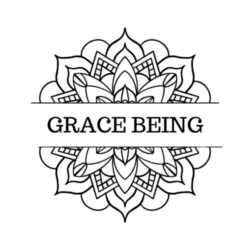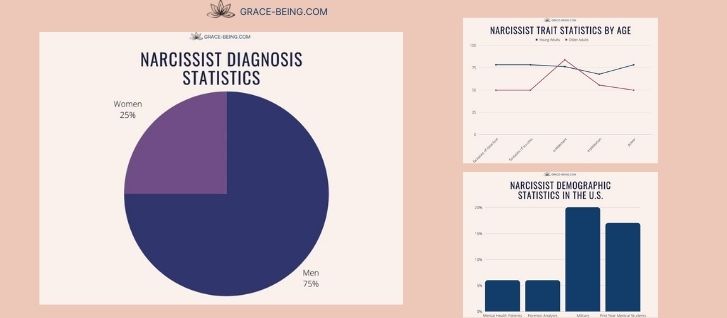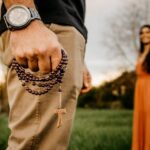Narcissistic Personality Disorder Statistics | 2022
My latest contemplative reflections intrigued me to research narcissistic personality disorder statistics to see how the rise of this mental health issue is impacting what we’re going through on a global scale.
If you’re a victim of narcissistic abuse and would like to embark on a healing journey, the Narcissistic Abuse Recovery Program can help you. (If you prefer one-to-one sessions, I offer Narcissistic Abuse Counseling personalized sessions according to your needs and specific situation).
NPD Statistics
In this article, I explored several studies and publications about narcissist statistics and combined all the data in one article. This report takes into consideration the following elements:
- gender
- race
- age
- marital status
- personality traits
- criminal behavior
- demographics in the US
- substance abuse & other mental disorders
- treatment
- narcissistic abuse on victims
Statistics of Narcissistic Personality Disorder: How Common is it?
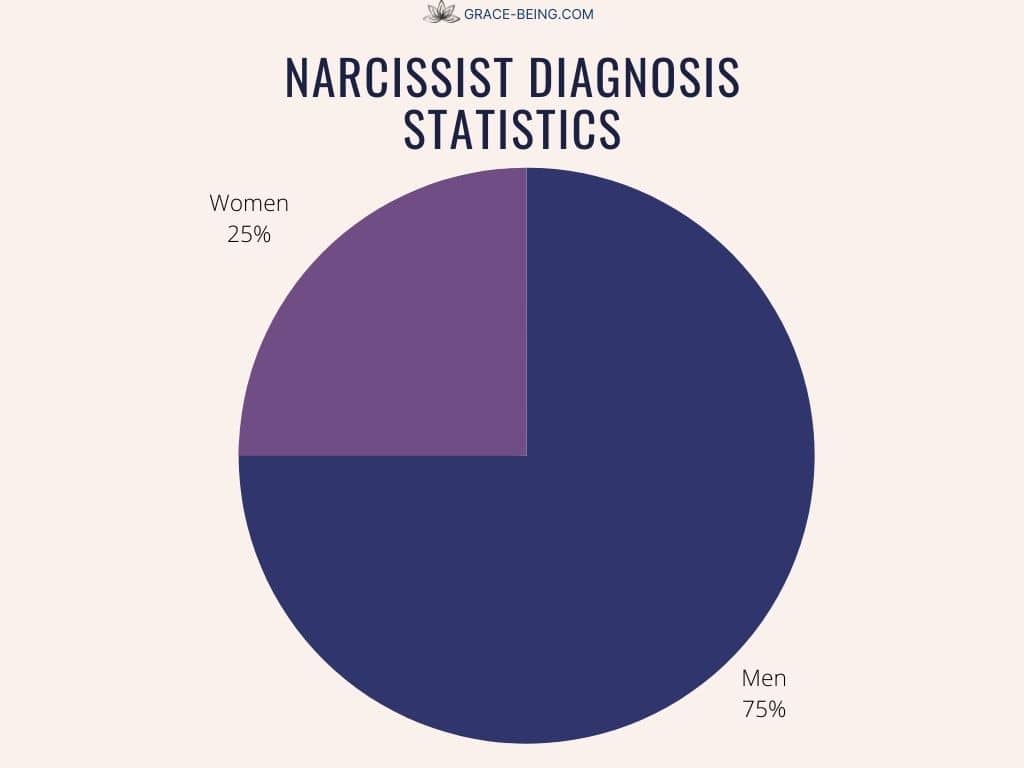
According to researchers, up to 5% of people suffer from narcissistic personality disorder, also called NPD. Many people have narcissistic traits, however narcissistic personality disorder is more severe and needs to be diagnosed by a licensed professional. Around 75% of people who are diagnosed with narcissistic personality disorder are men.
Narcissist Gender Statistics
A study by J Clin Psychiatry published in the National Library of Medicine, collected data from 34,653 adults who participated in face-to-face interviews.

Narcissist statistics results showed that prevalence of lifetime NPD was 6.2%. The rates show that NPD characteristics were 7.7% more prevalent in men. Out of the total number of participants 4.8% women showed NPD traits and characteristics.
These are the criteria listed by the Diagnostic and Statistical Manual of Mental Disorders, 5th Edition: DSM-5 to diagnose NPD:
- Grandiose sense of self
- Preoccupied with fantasies of unlimited success, power, brilliance, beauty, or ideal love.
- Believes that he or she is “special” and unique and can only be understood by, or should associate with, other special or high status people (or institutions).
- Requires excessive admiration.
- Sense of entitlement, unreasonable expectations of favorable treatment or full compliance with his or her expectations.
- Exploitative, takes advantage of others to achieve his or her own ends.
- Lacks empathy: unable to recognize or identify with the feelings and needs of others.
- Envious of others or believes that others are envious of him or her.
- Shows arrogant, haughty behaviors or attitudes.
Narcissistic Traits and Characteristics

During this study, researchers analyzed what kind of narcissistic personality traits and characteristics are more prevalent in men and women.
The results showed that men scored higher when it comes to the following traits:
- Lack of empathy; men scored 83.1% higher than women who scored 72.3%.
- Sense of entitlement; men scored higher at 82.6% where women scored 77.1%.
- Exploitation; men scored higher with a score of 65.5%, while women scored 55.7%.
The narcissist statistics show that women take over when it comes to the following characteristics:
- Envy; women scored 78.4% while men scored 72.6%.
- Arrogance; women score higher at 42.0% while men scored at 35.7%.
Narcissistic Behavior Statistics by Race
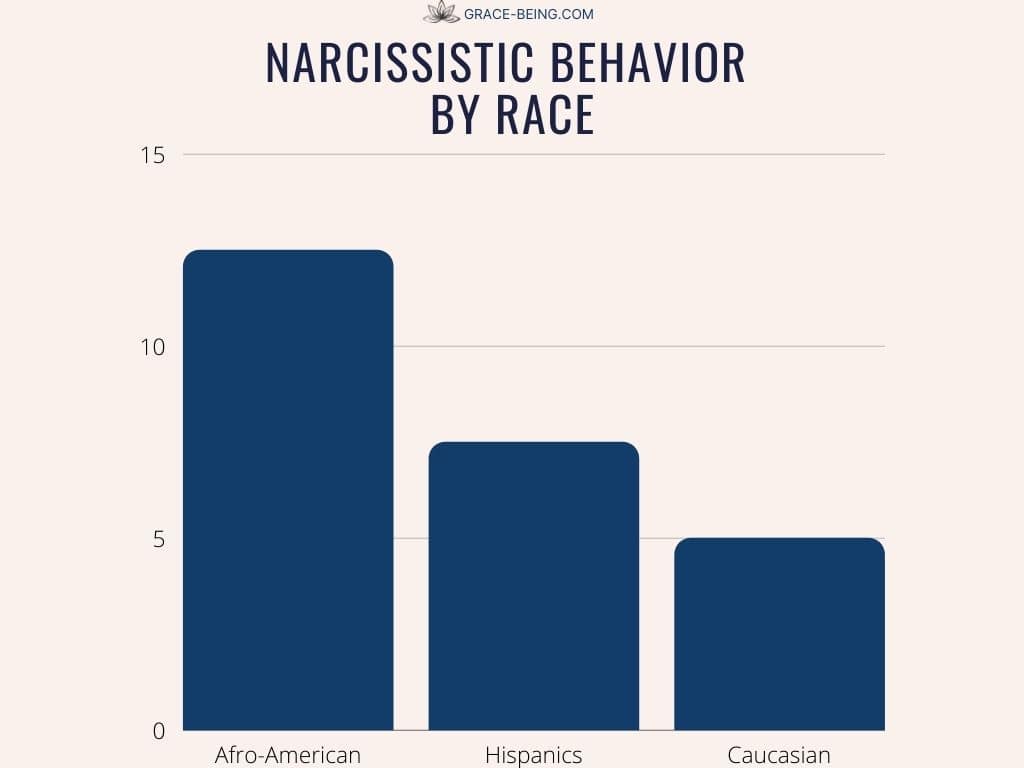
Throughout this study, results show that NPD was significantly more common among Afro-Americans at 12,5%, followed by Hispanics at 7.5%, and Caucasians at 5.0%.
Despite narcissism being higher in Afro-Americans and Hispanics, 87% of people diagnosed with NPD are Caucasian. This could be a result of easier access to therapy and treatment among Caucasians.
Statistics of Narcissistic Personality Disorder by Age
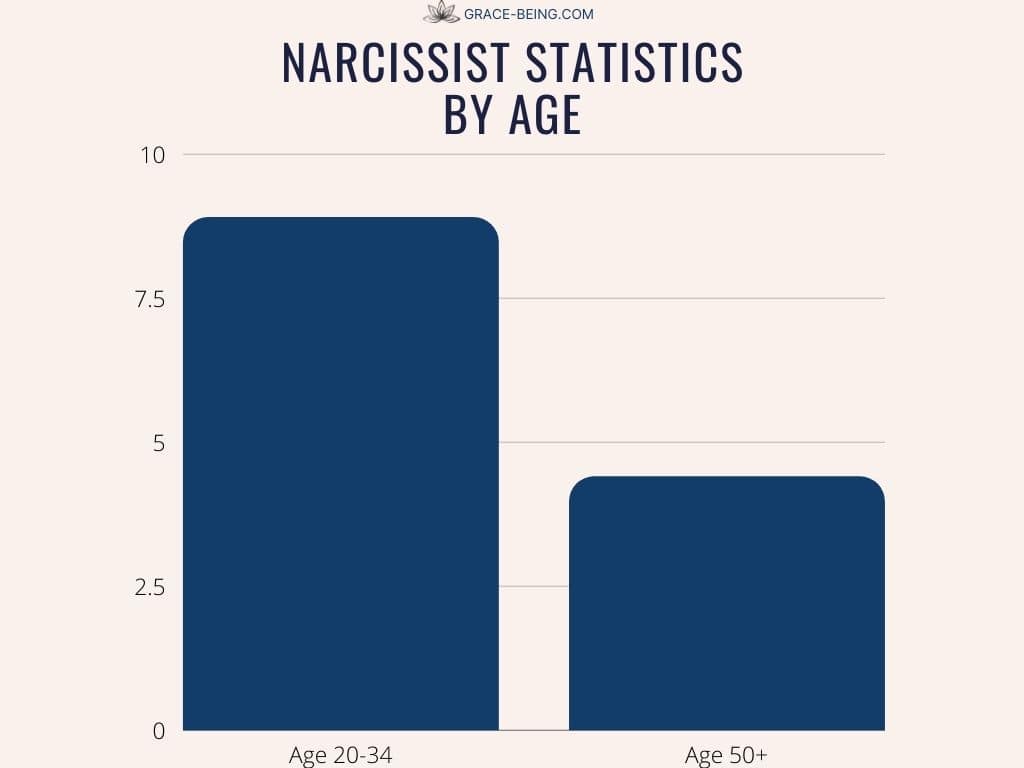
Research suggests that narcissism is more common among young adults between the age of 20 to 34. The data shows that narcissistic traits are less present in adults aged 50 years old or older.
This could be related to the fact that as people grow older, they start reflecting more about what really matters in life. Young adults see to be more pre-occupied with materialism, career goals, success, fame, beauty, control and power.
Another study suggests that NPD declines with age. Wilson and Sibley showed that in New Zealand, young adults in their twenties showed symptoms of NPD at a rate of 9.4%, while older adults at the age of 65+ scored less at 3.2%.
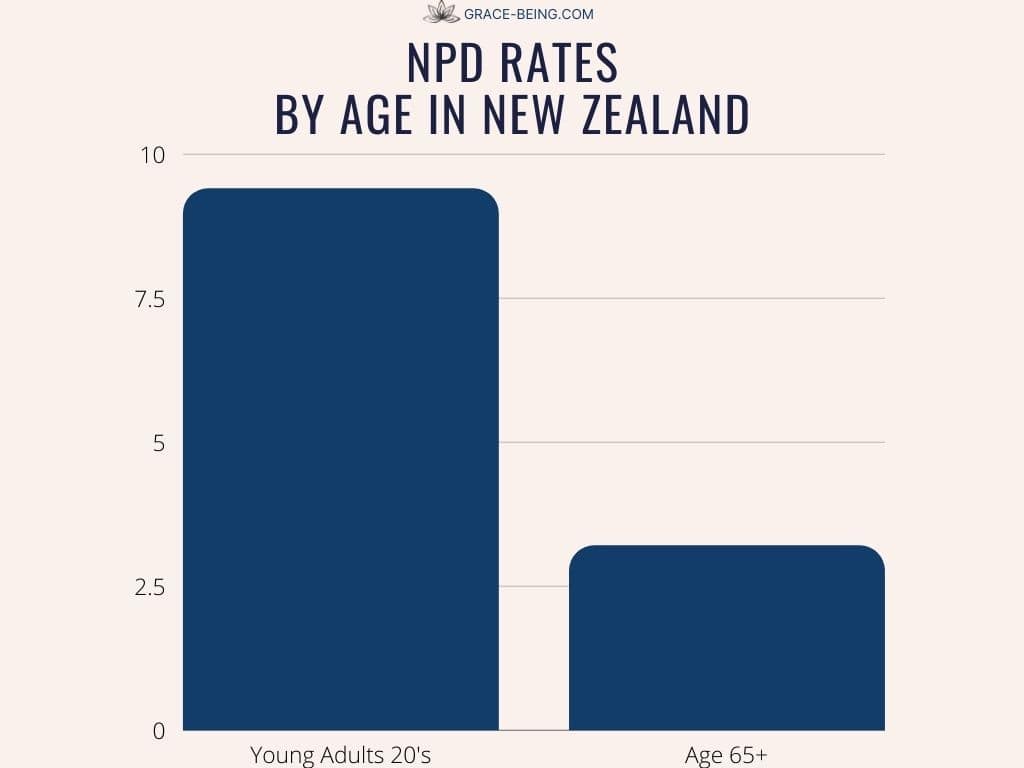
Several media publications and studies report that narcissism is on the rise in society. Undeniably, societies especially in Western cultures have evolved towards a more individualistic culture.
Social media influencers and celebrities have also contributed to the importance of self-image, fame, power and beauty. However, a recent study by Josh Grubbs, a psychology professor at Bowling Green State University resulted in an interesting observation.
The study was published in May 2019 and the data shows that emerging adults believe that there is an increase in narcissism among their age groups. When the participants were asked to share their opinion about narcissistic traits, they found these traits to be unpleasant and were distressed about narcissism.
Statistics about narcissistic personality disorder from this study show that young adults do not believe that having narcissistic traits is a good thing. Unlike what is expected from narcissists, emerging adults perceive these narcissistic traits in a negative light.
Narcissistic Traits Statistics by Age
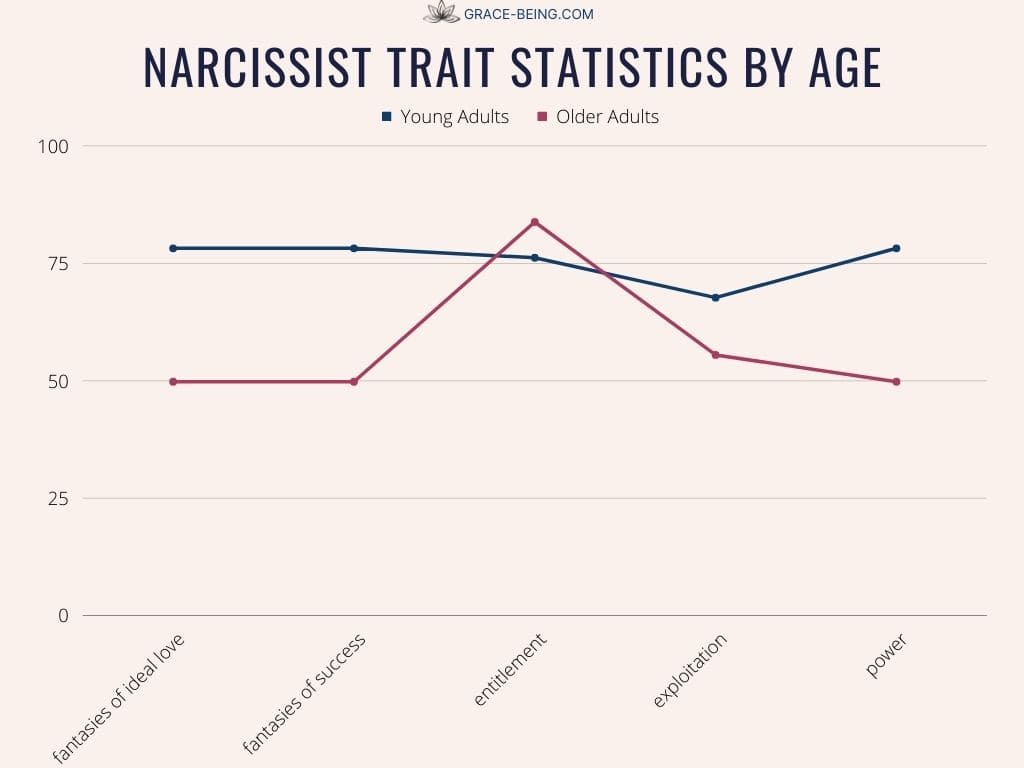
Studies compared narcissistic traits and characteristics between young adults and older individuals.
The data shows that young adults scored higher when it comes to the following traits:
- fantasies of ideal love, unlimited power & success; young adults scored at 78.2% while older adults scored at 49.8%.
- exploitation; young adults scored at 67.7% compared to older adults who scored at 55.5%
On the other hand, when it comes to having a sense of entitlement, older adults scored higher with a score of 83.8%, where young adults scored at 76.2%.
Narcissist Statistics Marital Status
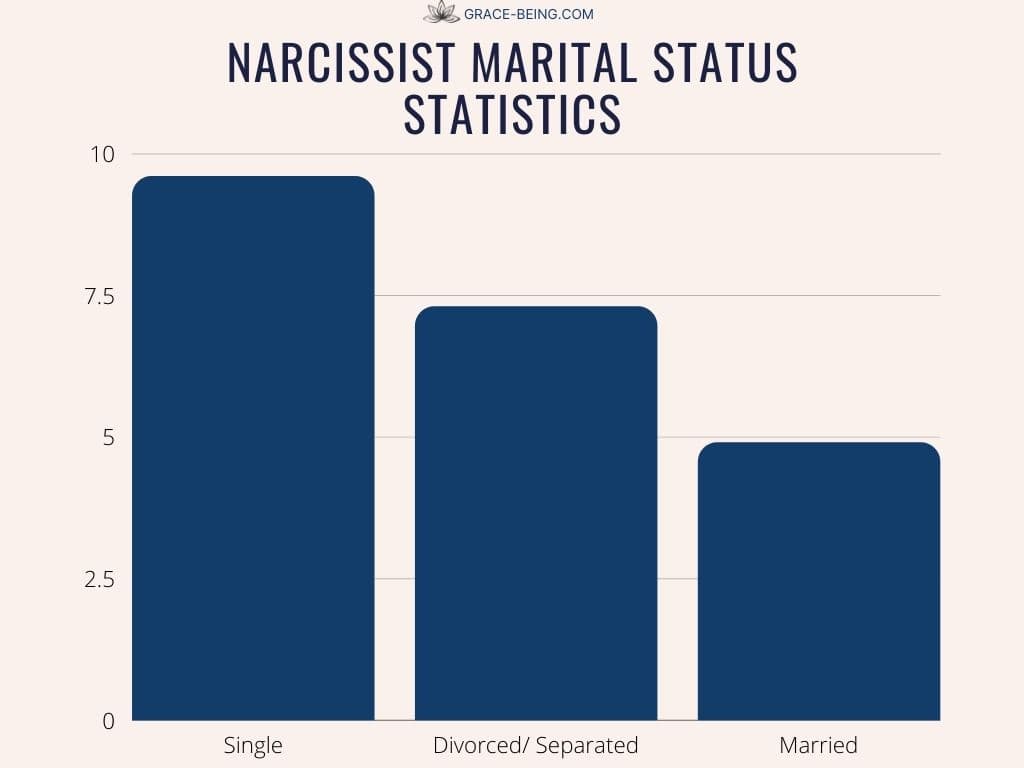
When it comes to marital status, the statistics show that there are more single narcissists (9.6%), followed by 7.3% divorced or separated, and 4.9% of narcissists are married.
The results are not surprising considering how difficult it is for narcissists to maintain healthy and long-lasting relationships.
Related: Divorcing a Narcissist
Traits of Narcissistic Personality Disorder Statistics

As listed on the criteria of the DSM-V, there are common personality traits and characteristics in people with narcissistic personality disorder.
Studies suggest that people who have high neuroticism and extraversion (two personality traits from the Big 5 personality traits) are more likely to develop grandiose narcissism. On the other hand, people who are more introverted have a higher chance of developing vulnerable narcissism.
When researches compared the data, results show that the majority of narcissists think that they are unique or special with a score of 82.1%. When it comes to having a sense of entitlement, narcissists scored at 80.4%, followed by lack of empathy with a score of 78.8%.
Statistics of Narcissists linked to Criminal Behavior
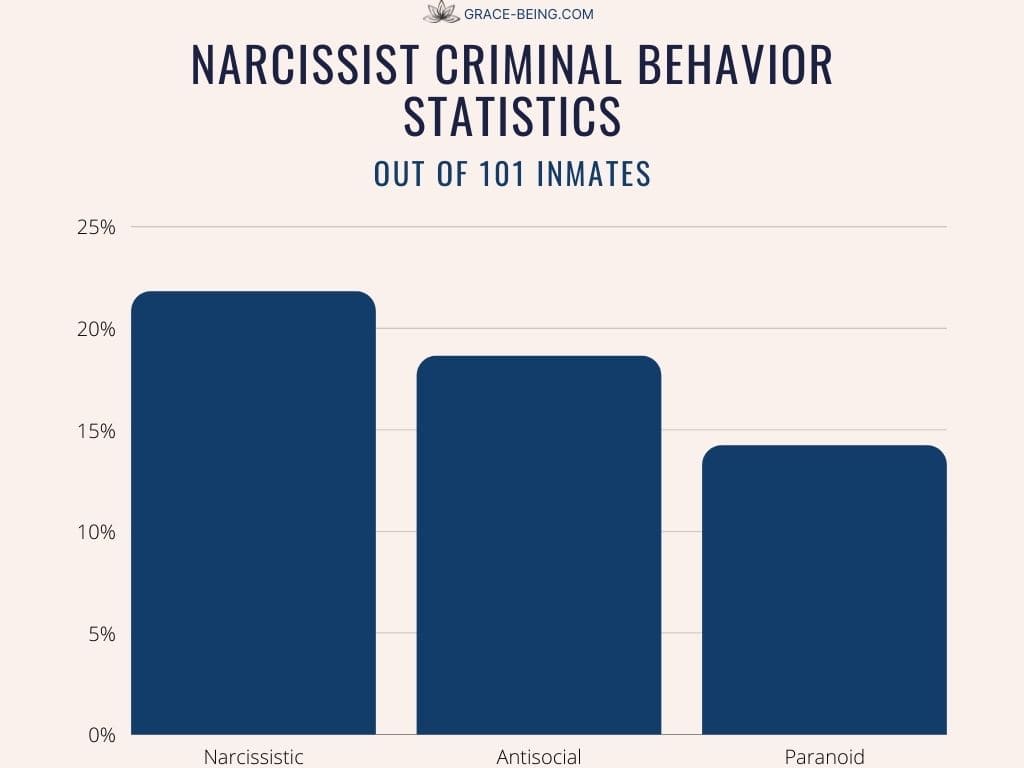
Any type of personality disorder is associated with a higher risk of committing crimes and engaging in criminal behavior.
A study that involved 101 inmates underwent a diagnosis of personality disorder. Statistics show that narcissistic personality disorder was more prevalent among prisoners.
Diagnostic analysis of personality disorders among inmates:
- Narcissistic – 21.08%
- Antisocial – 18.63%
- Paranoid – 14.22%
Statistics also show that individuals who suffer from NPD are more likely to suffer from anger management issues and feelings of hatred. Narcissists are also more likely to engage in abusive behavior towards their partners.
Narcissistic Personality Disorder Statistics in the US
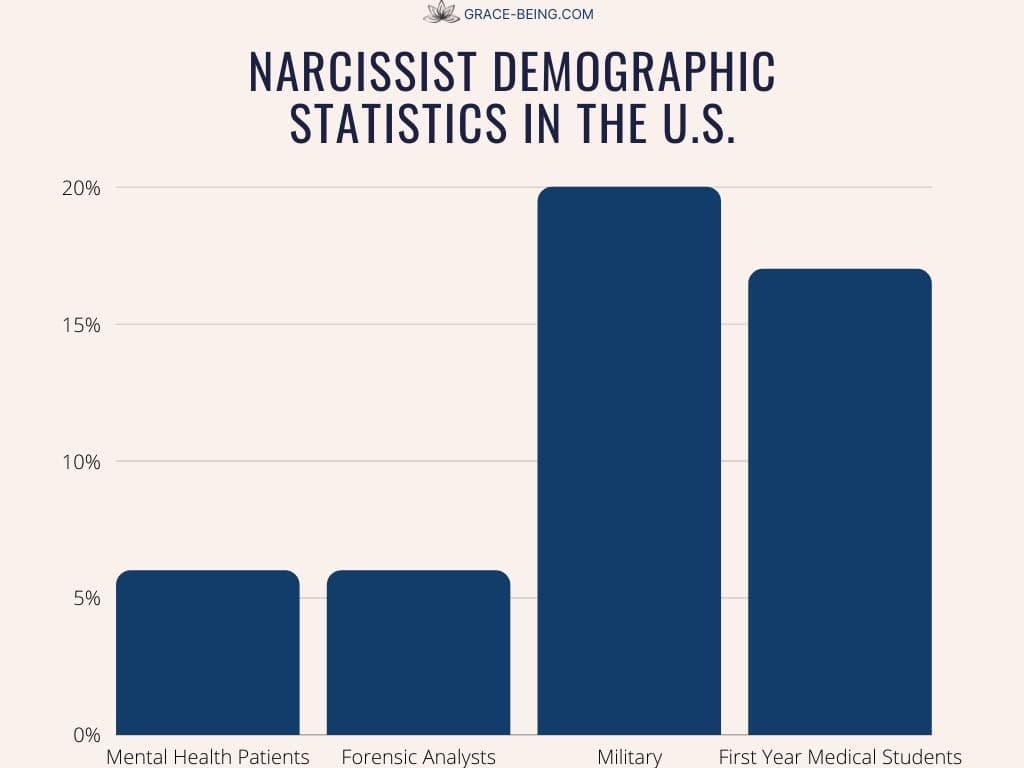
When it comes to narcissistic personality disorder statistics in the U.S., results show that certain demographics scored higher:
- Around 6% mental health patients
- 6% of forensic analysts
- 20% military people
- 17% first-year medical students
Narcissistic Statistics, Substance Abuse & Other Disorders
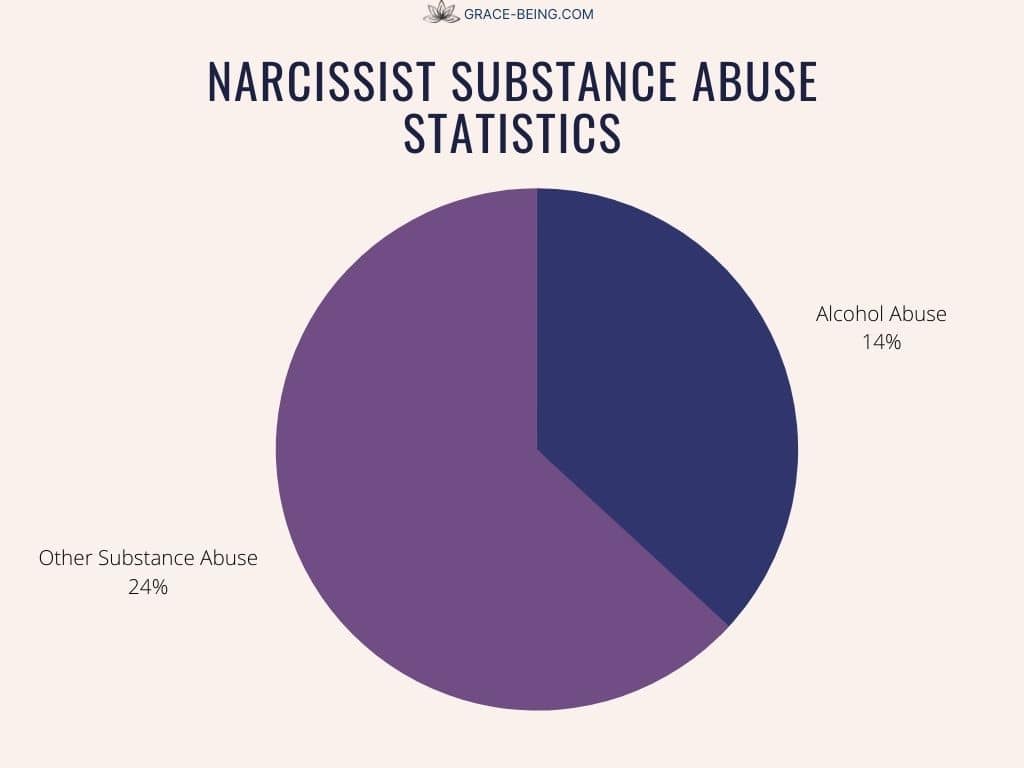
It’s quite common that individuals who suffer from NPD end up having problems with substance abuse. Narcissists often use drugs or alcohol to cope with their overwhelming emotions, frustration, and anxiety that comes with this mental health issue.
Statistics show that 14% of people with NPD end up developing an alcohol disorder, and 24% of people with NPD abuse from other types of drugs.
Narcissistic Personality Disorder & Other Disorders Statistics
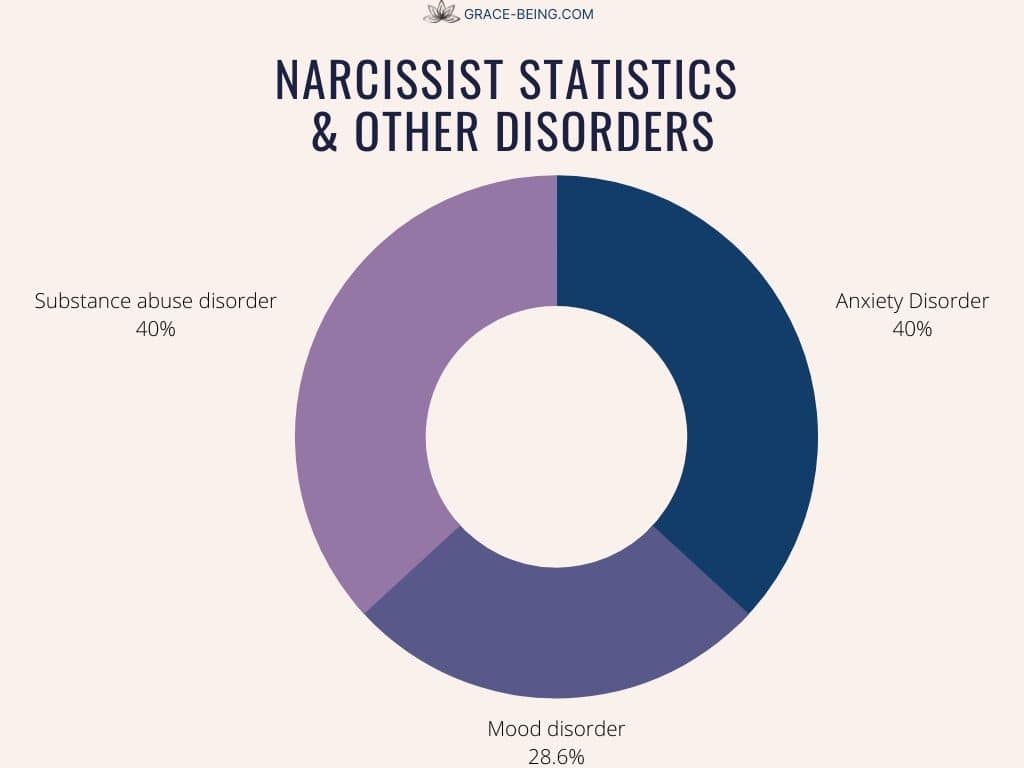
Researchers also analyzed people with NPD and investigated the correlation between narcissism and other disorders.
- Around 40% of people with NPD develop a substance abuse disorder
- 40% of people with NPD also suffer from an anxiety disorder
- 28.6% of people with NPD suffer from a mood disorder
What Percentage of Narcissists Stop their treatment?
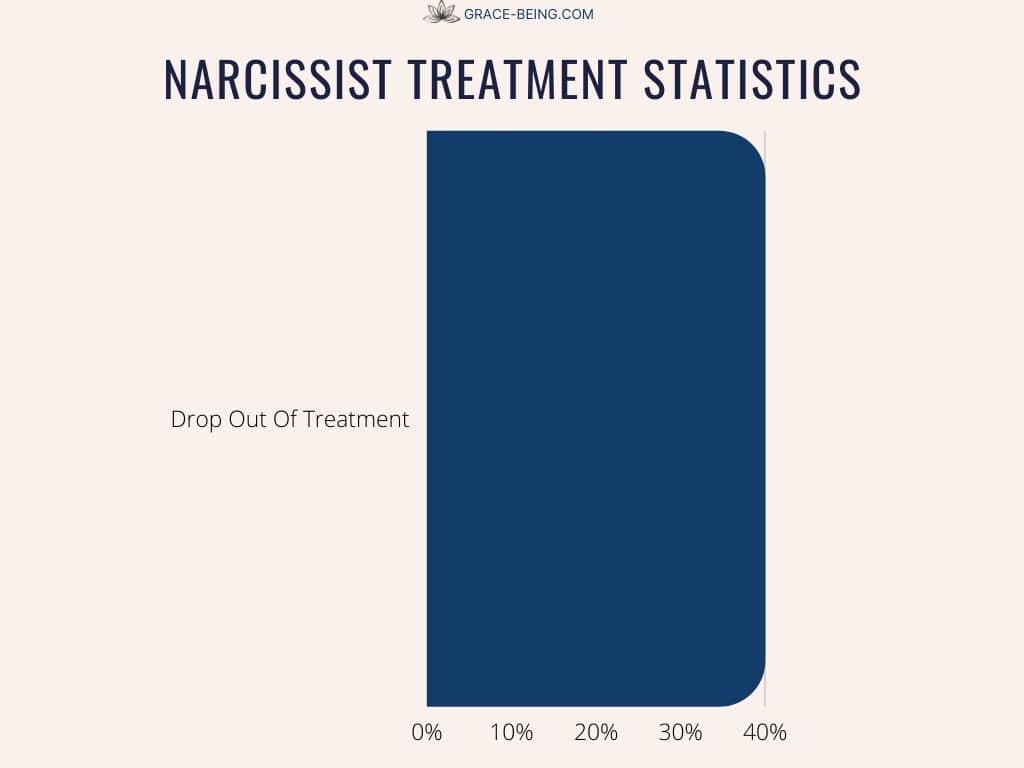
People who suffer from narcissistic personality disorder rarely seek treatment. This is due to their perception of their own self-image as they see themselves as special, unique, and above standard.
Their fragile ego is unable to accept any flaws or imperfections, and thus inflates their own self-image to improve their own self-esteem. Moreover, they project their imperfections on others, and blame others for everything that goes wrong.
A small percentage of narcissists seek treatment when they hit rock bottom, or because they are forced by their partners to go the therapy. Unfortunately the successful rates are quite low due to the severity of the personality disorder in itself.
Statistics show that around 40% of NPD sufferers who seek treatment, end up dropping out of therapy. Progress and change happens very slowly with narcissists, so they might be discouraged or feel uncomfortable during therapy. This drives them to stop their therapy and revert to old behavioral habits.
Narcissistic Abuse Statistics
Narcissistic abuse shouldn’t be taken lightly. Victims of narcissistic abuse suffer from long-term effects and it takes a long time to heal the emotional trauma.
The founder of the Institute for Relational Harm Reduction and Public Pathology Education Sandra L. Brown, reported that 60 Million people in the US suffer from abuse due to other people’s pathology and personality disorders.
During her observation and research, Brown estimated the U.S. population to be about 304 million people. She states that approximately, 12 million people in the United States suffer from a personality disorder.
Based on these numbers, Brown argues that if these individuals had approximately 5 partners each, over 60 million people end up being victims of narcissistic abuse. Of course, these numbers are just estimates based on her hypothesis and observation. However, it is an indication of how common narcissistic abuse is among society.
Final Thoughts
Several studies and publications about narcissistic personality disorder shed light on the negative effects of this mental health illness.
From tyrants and dictators, to domestic abuse, substance misuse, and the severe effects of narcissistic abuse, statistics show that we should not take this lightly.
If you are in a relationship with a narcissistic person, it’s important to reflect on these statistics. This mental health issue is not something that can be fixed with your support, compassion and understanding.
Most victims tend to think that they can help their abusers or show empathy and compassion towards them. Keep in mind that the same level of compassion and empathy will not be reciprocated by a narcissist and it is not your problem to fix.
Joy, fulfillment and happiness await you in your new life chapter. This chapter does not involve the narcissist. It involves, self-love, healing, self-compassion, and learning how to cultivate a healthy secure attachment style. Once you get over the trauma bond, you start seeing things more clearly and realize that life doesn’t need to be like this forever.
My Related Services:
–Narcissistic Abuse Recovery Program: Join a structured program that provides tools, resources, and guidance to help you navigate and heal from the impact of narcissistic abuse.
–Mindfulness Meditation Practice: Discover the power of mindfulness with me as your meditation teacher. This practice has been a transformative tool in helping me gain mental clarity, rebuild self-trust, and respond consciously rather than reacting impulsively. Book a free call today and learn how mindfulness can calm your nervous system and bring peace into your life.
–Email Advice: Get guidance, insights, and support directly to your inbox.
FAQs
Up to 5% of people suffer from narcissistic personality disorder, according to researchers. Many people have narcissistic traits, however narcissistic personality disorder is more severe and needs to be diagnosed by a licensed professional.
Out of 34,653 adults, men were 7.7% more prevalent when it comes to narcissistic traits. Out of the total number of participants 4.8% women showed NPD traits and characteristics.
Around 40% of people who seek treatment for narcissistic personality disorder, drop out of treatment. Progress and change happens very slowly with narcissists, so they might be discouraged or feel uncomfortable during therapy. This drives them to stop their therapy and revert to old behavioral habits.
References:
https://barendspsychology.com/narcissism-facts/
https://www.jstor.org/stable/3792241
https://my.clevelandclinic.org/health/diseases/9742-narcissistic-personality-disorder
https://psychiatry.org/psychiatrists/practice/dsm
https://www.ncbi.nlm.nih.gov/pmc/articles/PMC2669224/
http://archive.boston.com/lifestyle/health/articles/2011/01/24/many_experts_are_considering_a_redefinition_of_narcissism/
https://emedicine.medscape.com/article/1519417-overview#a5
https://www.choosingtherapy.com/narcissistic-personality-disorder/
https://www.ncbi.nlm.nih.gov/pmc/articles/PMC6813663/
https://saferelationshipsmagazine.com/60-million-persons-in-the-us-negatively-affected-by-someone-elses-pathology-2
https://journals.plos.org/plosone/article?id=10.1371/journal.pone.0215637
https://www.ncbi.nlm.nih.gov/pmc/articles/PMC5783345/
